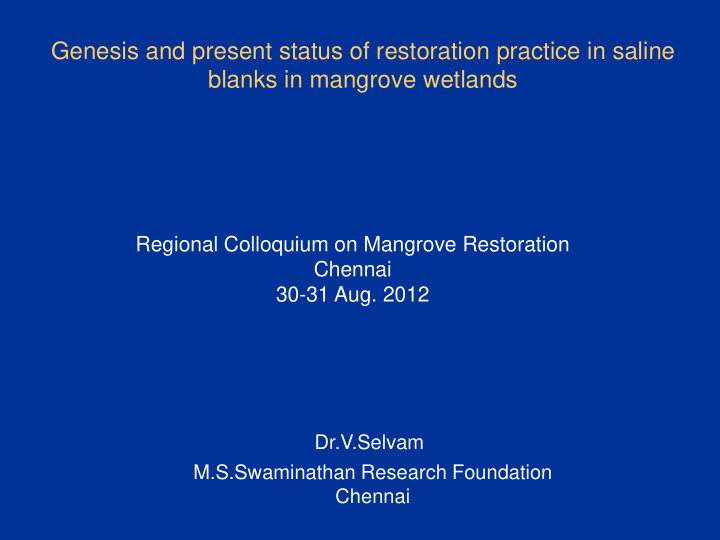



Genesis and present status of restoration practice in saline blanks in mangrove wetlands Regional Colloquium on Mangrove Restoration Chennai 30-31 Aug. 2012 Dr.V.Selvam M.S.Swaminathan Research Foundation Chennai
Saline blanks common in arid and semi-arid mangrove Muthupet mangroves – Tamil Nadu Saline blanks Saline blanks Saline blanks Wetland boundary Mangrove vegetation
Saline blanks in Krishna mangroves – Andhra Pradesh Saline Blank SB SB SB Mangroves SB SB River SB SB SB – Saline Blanks
Past attempts to restore saline blanks… Declared as Reserve Forest 100 to 140 years back Managed by British Forest Department – till independence Forest Department of Indian States – after 1947 Working plans – 10 years interval available since declared as RF Working plans after 1930s – recorded presence of saline blanks Recorded attempts to restore saline blanks –limited results This situation existed till 1992
MSSRF started working in Pichavaram mangroves in 1992 Declared as Reserve Forest in 1911 Small mangroves – 1470 ha 1992 remote sensing data – 55% SB SB forested area degraded SB SB SB SB 1986
First step of restoration: Analysis of causes of degradation Views of Govt. agencies + other institutions Exploitation by local community Grazing and illegal felling Local community No felling of green trees Cattle grazing is only in peripheral areas Degradation is severe in the middle portion of mangroves
Villagers statements verified and found true during field visits Observed stagnation of tidal water in the degraded areas and free flushing in healthy mangrove areas Hypothesized changes in microtopography resulted in stagnation of tidal water
Community participated Ecological Investigation Tidal flushing Microtopography Mangrove health Soil and ground water Property
Topography in healthy areas Smooth topography; free flushing by tidal water Soil salinity is moderate - 12 to 51 ppt Pore water salinity is moderate - 22 to 64 ppt High diversity of species
Topography in degraded areas Topography is trough shaped; stagnation of tidal water Soil salinity is high- 68 to 115 ppt Pore water salinity is high - 70 to 120 ppt Dead mangrove trees, stunted growth
Development of trough shaped topography leading to development of hyper saline condition- main reason for degradation Observation supported by Remote sensing data
What caused topography become trough shaped ? Past unscientific management practices Mangrove forests clear felled under coupe system for revenue generation to govt. 20 years rotation Started in 1930s and continued till 1970s Every year about 12 to 15 ha of mangrove forest clear felled Exposure of wetland triggered a chain reaction
What caused topography become trough shaped ? Clear felling Exposure of mangrove Evaporation of under coupe system wetland soil water Subsidence of Stagnation of Development of trough sediment Tidal water Shaped topography Evaporation of Development of No regeneration Tidal water hyper salinity
Development of restoration technique Hypothesized that trough shaped degraded can be easily restored if facilities are provided for free flow of tidal water in and out during the high tide and low tide Tested this hypothesis in about 8.00 ha of degraded area with the participation of the community
Canal system for free tidal flushing 3 m 1.8 m 1 m 80 cm
Before restoration After restoration
Joint Mangrove Managem ent A number of questions - Who will maintain the canals? - How social pressures, there is anything, can be prevented? - How to upscale restoration activities? Development of - Joint Mangrove Management Programme
Extended to 7 major mangroves of the east coast of India in Tamil Nadu Andhra Pradesh Orissa Sunderban Tripartite agreement between local communities, state Forest Department and M.S.Swaminathan Research Foundation
Process followed in JMM Situation analysis Identifying participating hamlets Participatory Rural Appraisal Establishment of Village Mangrove Council Identification of Mangrove Management Unit Preparation of a Joint perspective plan Preparation of joint annual action plan Joint Implementation and monitoring
Output 33 village level institutions with ~5240 families as members -Restored 1475 ha –6.8 millions of mangrove \ saplings -Conserving about 12000 ha of verdant mangroves developed a science-based, community-centred and process-oriented approach Outcome Ministry of Environment evaluated this approach and declared as the best available and included in the National Mangrove Action plan – led for more flow of resources to state Forest Departments
Pichavaram mangroves 1986 2002
Pichavaram mangroves Google Maps 2011
Godavari Mangroves – Andhra Pradesh A success story of Joint Mangrove Management 1986 2001
Recommendation Community-NGO-Government partnership should be promoted for better conservation and management of coastal ecosystems Location specific science-based, community-centred and process-oriented approach needs to be developed and promoted for sustainable management of coastal resources and ecosystems Concerns of user community should be incorporated in the coastal and marine governance framework by providing them opportunity to participate in the decision making and policy making processes to create a win-win situation
Recommend
More recommend